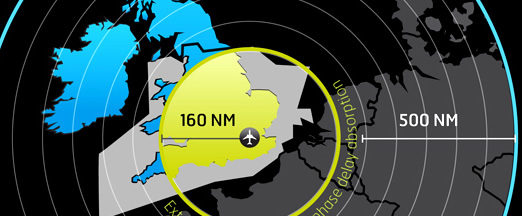Leaders in air traffic management head to Madrid for the World ATM Congress this week at a critical juncture for the industry.
Gone are the screaming headlines of Euro collapse of 2012/13, replaced instead with a cautious sense that economies may now be stabilising, even recovering.
So, is it also time for us all to think again about traffic growth? If we do, I believe we have a duty to ask ourselves…are we ready as an aviation industry?
It seems to me that the answer is clearly no. The short film on this page tries to visualise the movement of aircraft over 24 hours across Europe’s skies. The image that emerges is still one of congestion and inefficient routing….much as it has been for a decade or more. But rather than make hay while the sun shines during the recent years of low traffic volumes, the industry as a whole has really done very little to improve this picture.
Can’t view Vimeo? Try YouTube.
It’s not that everyone has been idle. The recession has given Air Navigation Service Providers the opportunity to improve service quality and the imperative to reduce costs. The issue that concerns me is that the return of higher volumes threatens to undermine these gains unless we take action on the wider network soon.
For example, at NATS we have reduced delay to a level that is inconsequential to airlines. The average delay per flight today over the UK is in single digit seconds. This was a distant dream 10 years ago, but due to the lack of progress to address fragmentation across European airspace, today’s numbers will inevitably drift back upward as traffic grows over coming years. At least, not without the application of significant effort and a risk of undoing some of hard work we have done to reduce cost during the downturn.
While stakeholders have not taken sufficient steps to improve the efficiency of European skies, the need for resilience in the entire airspace system, particularly where it is being operated at near full capacity, is also being overlooked. This will be highlighted at WAC in the session on Natural Disasters and Disruptive Events. I for one will be highlighting just how disproportionate an impact a relatively minor reduction in capacity can have on our customers, as we saw on 7th December when our capacity was reduced by just 10% for the day….and the considerable extent of planning required to deliver additional capacity for major events like the Olympics.
Against this rather negative assessment, all parties do have the opportunity and, I would say the necessity to progress, in fact accelerate SESAR. With this in mind, I am glad to see a focus on SESAR at the show and there will be some exciting presentations this week from my NATS colleagues on Time Based Separation and the Topflight programme. I also note that the first year of the UK’s Future Airspace Strategy Deployment Initiative, aka SESAR in the UK, has been nominated for a Jane’s Award. Recognition for a truly collaborative cross-industry group that is delivering real SESAR concepts into operation would be well deserved.
But I have to say that some of the most important discussions will be taking place in the side-lines of the conference. For example, the A6 group of ANSPs are meeting to decide the approach it will take to the Commission’s latest proposal for the SESAR Deployment Manager. This decision could be key to the future of SESAR. We are also very much looking forward to our meetings at the show with the A4 group of airlines about how to deploy SESAR and of course with the Commission.
The World ATM Congress is a great way for the industry to catch up, but we need to use it as an important opportunity to accelerate and get ourselves ready for the recovery we all hope is ahead.
Comments
Please respect our commenting policy and guidelines when posting on this website.




